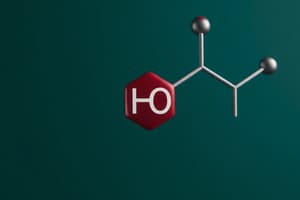Podcast
Questions and Answers
What is the symbol used to represent the phenyl substituent?
What is the symbol used to represent the phenyl substituent?
- CH3
- C6H5 (correct)
- CH2
- Ph (correct)
What is the prefix used to name a disubstituted benzene with substituents on adjacent carbon atoms?
What is the prefix used to name a disubstituted benzene with substituents on adjacent carbon atoms?
- meta
- ortho (correct)
- para
- iso
When naming a benzene with more than two substituents, how are the substituents presented in the name?
When naming a benzene with more than two substituents, how are the substituents presented in the name?
- In order of electronegativity
- In alphabetical order (correct)
- In order of molecular weight
- In order of reactivity
What is the empirical formula of benzene?
What is the empirical formula of benzene?
What is the structure of benzene according to the resonance theory?
What is the structure of benzene according to the resonance theory?
What is the term used to describe each of the two equivalent structures of benzene?
What is the term used to describe each of the two equivalent structures of benzene?
What is a characteristic of monosubstituted benzene?
What is a characteristic of monosubstituted benzene?
What is a limitation of the Kekulé structure?
What is a limitation of the Kekulé structure?
What is a result of the delocalization of the π system of electrons in benzene?
What is a result of the delocalization of the π system of electrons in benzene?
Why does benzene react slowly with Br2?
Why does benzene react slowly with Br2?
What is the hybridization of the carbon atoms in the benzene molecule?
What is the hybridization of the carbon atoms in the benzene molecule?
What is the shape of the benzene molecule?
What is the shape of the benzene molecule?
What is the energy released when cis-Cyclooctene is hydrogenated to cyclooctane?
What is the energy released when cis-Cyclooctene is hydrogenated to cyclooctane?
What is the resonance energy of benzene?
What is the resonance energy of benzene?
What type of reagents are used in electrophilic fluorination instead of elemental fluorine?
What type of reagents are used in electrophilic fluorination instead of elemental fluorine?
What is the catalyst used in the reaction of Cl2 and Br2 with benzene?
What is the catalyst used in the reaction of Cl2 and Br2 with benzene?
What is the limitation of Friedel-Crafts alkylation reactions with respect to aromatic rings?
What is the limitation of Friedel-Crafts alkylation reactions with respect to aromatic rings?
Which of the following substituents are ortho- and para- directors?
Which of the following substituents are ortho- and para- directors?
What is the reaction that involves the reduction of carbonyl compounds to alkanes?
What is the reaction that involves the reduction of carbonyl compounds to alkanes?
What is required for iodine to react with aromatic rings?
What is required for iodine to react with aromatic rings?
What is the role of electrophilic aromatic halogenation in the biosynthesis of thyroxine?
What is the role of electrophilic aromatic halogenation in the biosynthesis of thyroxine?
What is the product of the oxidation of alkyl benzenes with strong oxidizing agents such as acidified KMNO4?
What is the product of the oxidation of alkyl benzenes with strong oxidizing agents such as acidified KMNO4?
What is necessary for benzene to react with bromine?
What is necessary for benzene to react with bromine?
What is the electrophile in aromatic nitration?
What is the electrophile in aromatic nitration?
What is the reason for using dilute HNO3 in the nitration of phenol?
What is the reason for using dilute HNO3 in the nitration of phenol?
What type of substituents make the aromatic ring more reactive in electrophilic aromatic substitution reactions?
What type of substituents make the aromatic ring more reactive in electrophilic aromatic substitution reactions?
Which of the following is NOT a meta-directing substituent?
Which of the following is NOT a meta-directing substituent?
How is the electrophile for sulfonation of benzene generated?
How is the electrophile for sulfonation of benzene generated?
What is the catalyst used in Friedel-Crafts acylation reactions?
What is the catalyst used in Friedel-Crafts acylation reactions?
What type of reaction occurs in the biosynthetic pathways of phylloquinone (Vit.K)?
What type of reaction occurs in the biosynthetic pathways of phylloquinone (Vit.K)?
What is the role of aromatic hydroxylation in drug metabolism?
What is the role of aromatic hydroxylation in drug metabolism?
How many bromine atoms are present in the product formed when phenol reacts with bromine?
How many bromine atoms are present in the product formed when phenol reacts with bromine?
What is the purpose of aromatic sulfonation in industry?
What is the purpose of aromatic sulfonation in industry?
What is the reaction that involves the formation of alkyl substituted benzenes from aryl halides and alkyl halides?
What is the reaction that involves the formation of alkyl substituted benzenes from aryl halides and alkyl halides?
What is the factor that controls the electron donation or electron withdrawal ability of substituents?
What is the factor that controls the electron donation or electron withdrawal ability of substituents?
What is the limitation of Friedel-Crafts alkylation reactions with respect to alkyl halides?
What is the limitation of Friedel-Crafts alkylation reactions with respect to alkyl halides?
Flashcards are hidden until you start studying
Study Notes
Nomenclature of Aromatic Compounds
- The phenyl substituent is represented as Ph or C6H5-
- Prefixes used for naming disubstituted benzenes are:
- Ortho (o)
- Meta (m)
- Para (p)
- When there are more than two substituents on the benzene ring, the point of attachment is chosen as carbon 1 and numbering is done to give lower locants to the substituents.
- Substituents are presented in alphabetical order when writing the names.
Structure and Stability of Benzene
- The structure of benzene is described by two theories: resonance and molecular orbital theories.
- Empirical formula of benzene is C6H6, with no structure assigned.
- Kekulé proposed the structure of benzene as a six-membered carbon-atom ring with alternating single and double bonds.
- The molecule oscillates between two equivalent structures (A and B) where the single and double bonds continuously interchange positions.
- The actual structure of benzene is a hybrid of the two Kekulé structures (A and B), which leads to the resonance hybrid (C).
- Each of structures (A) and (B) is called a canonical form of benzene.
- Evidence in support of the Kekulé structure of benzene:
- Monosubstituted benzene always forms only one product (isomer).
- Disubstituted benzene forms three products (isomers).
- Limitations of the Kekulé structure:
- Does not explain why benzene fails to undergo addition reactions typical of alkenes.
- Does not account for the equal length of carbon-carbon bonds (139 pm) in benzene.
- Does not explain the unusual stability of benzene (150 kJ/mol resonance energy).
Molecular Orbital Theory
- The carbon atoms of the benzene molecule are sp2-hybridized with each C-atom having an unhybridized p-orbital perpendicular to the plane of the benzene ring.
- Each p-orbital overlaps equally well with both neighboring p-orbitals.
- The 6 π electrons of benzene are completely delocalized around the ring, with electron density in all C-C bonds being identical.
- The delocalization of the π system of electrons affords benzene its unusual stability.
- The benzene molecule is conjugated and planar with the shape of a regular hexagon.
Why is Benzene not an Alkene?
- Treatment of cyclohexene with Br2 rapidly leads to the addition product 1,2-dibromocyclohexane.
- However, benzene reacts only slowly and requires a catalyst to produce the substitution product bromobenzene.
- Comparison of heats of hydrogenation of cyclooctatetraene, cyclohexenes, and benzene:
- When cis-cyclooctene is hydrogenated to cyclooctane, 96 kJ/mol of energy is released.
Electrophilic Aromatic Substitution Reactions
- Aromatic halogenation:
- Cl2 and Br2 react with benzene in the presence of FeCl3/FeBr3 catalysts to form chloro/bromo benzenes.
- Iodine is rather unreactive towards aromatic rings, but in the presence of oxidizing agents such as CuCl2 or H2O2, a reaction takes place leading to the formation of iodobenzene.
- Aromatic nitration:
- A mixture of conc. HNO3 and H2SO4 produces a nitronium ion (NO2+) which reacts as the electrophile.
- Aromatic nitration does not occur in nature, but the nitro group can be reduced to produce corresponding arylamine (ArNH2) such as aniline.
- Aromatic sulfonation:
- The electrophile for sulfonation of benzene can be generated when one molecule of H2SO4 protonates another and loses a molecule of water.
- Aromatic sulfonation can also be achieved when the aromatic ring reacts with fuming sulfuric acid (a mixture of H2SO4/SO3).
- Aromatic sulfonation does not occur in nature, but it is utilized in the synthesis of dyes and pharmaceuticals such as sulfanilamide.
- Aromatic hydroxylation:
- Hydrolysis of benzene diazonium salts to produce phenols.
- Aromatic hydroxylation is an important reaction in drug metabolism leading to excretion of drug metabolites.
Aromatic Alkylation
- Synthesis of aromatic hydrocarbons can be achieved through one of the following named reactions:
- Friedel-Crafts alkylation reaction
- Clemensen's reduction
- Wurtz-Fittig reaction
- Mechanism of aromatic alkylation:
- Limitations of Friedel-Crafts alkylation reactions:
- Only alkyl halides can be used for this reaction.
- The reaction is not feasible with aromatic rings already having electron-withdrawing substituents or amino groups.
- It is difficult to control polyalkylation.
- There can be skeletal rearrangement of the alkyl electrophile into a more stable carbocation.
- Limitations of Friedel-Crafts alkylation reactions:
- Aromatic alkylation reactions occur in a number of biosynthetic pathways such as the synthesis of phylloquinone (Vit. K).
Friedel-Crafts Acylation Reactions
- An aromatic compound is treated with an alkyl chloride (RCl) in the presence of AlCl3 catalyst.
- The electrophile is generated by AlCl3-assisted dissociation of an alkyl halide.
- The aromatic ring is acylated with acyl chloride (ROCl) in the presence of AlCl3.
Clemmensen's Reduction
- Reduction of carbonyl compounds to alkanes using Zn/Hg and HCl.
Wurtz-Fittig Reaction
- The reaction involves aryl halides and alkyl halides in the presence of Na in dry ether to form alkyl-substituted benzenes.
Oxidation of Alkyl Benzenes
- Oxidation of alkyl benzenes with strong oxidizing agents such as acidified KMNO4 produces benzoic acid.
Effect of Substituents in Electrophilic Aromatic Substitution Reactions
- Reactivity of the aromatic ring:
- Activating substituents make the aromatic ring more reactive (e.g. –NH2, -OH, -OCH3, etc.).
- Deactivating substituents render the aromatic ring less reactive than benzene (e.g. –CHO, -NO2, -CO2H, -CO2R, -NR3+, etc.).
- Substituents influence the orientation of the reaction by being either ortho/para- directors or meta- directors.
- Generally, substituents can be classified into ortho- and para-directing activators, ortho- and para-directing deactivators, and meta-directing deactivators.
Electrophilic Substitution on Phenols
- Benzene reacts with bromine only in the presence of Lewis acid catalysts.
- Phenols react rapidly (3x faster) without a catalyst with bromine to form a product containing three bromine atoms (2,4,6-tribromophenol) at specific positions.
Nitration of Phenol
- Nitration of phenol is problematic under normal nitration conditions since concentrated HNO3 oxidizes phenols.
- Dilute HNO3 is used instead.
Preparation of Paracetamol and Aspirin from Phenol
- How to prepare paracetamol from phenol.
- How to prepare salicylic acid and acetylsalicylic acid (aspirin) from phenol.
Studying That Suits You
Use AI to generate personalized quizzes and flashcards to suit your learning preferences.




